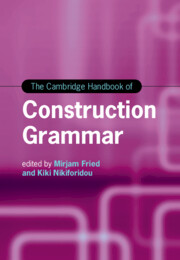Book contents
- The Cambridge Handbook of Construction Grammar
- Cambridge Handbooks in Language and Linguistics
- The Cambridge Handbook of Construction Grammar
- Copyright page
- Contents
- Figures
- Tables
- Contributors
- Acknowledgments
- Construction Grammar
- Part I The Constructional View of Language
- Part II Methodological and Empirical Foundations of Constructional Research
- Part III Case Studies in Constructional Morphosyntax
- Part IV Multimodality and Construction Grammar
- Part V Constructions in Sociocultural and Typological Variation
- 17 Constructions in Typological and Cross-Linguistic Context
- 18 Constructions and Language Contact
- 19 Constructions and Lectal Variation
- 20 Construction Discourse
- Part VI Constructional Applications
- Index of Terms
- Index of Languages
- Index of Constructions
- References
20 - Construction Discourse
from Part V - Constructions in Sociocultural and Typological Variation
Published online by Cambridge University Press: 30 January 2025
- The Cambridge Handbook of Construction Grammar
- Cambridge Handbooks in Language and Linguistics
- The Cambridge Handbook of Construction Grammar
- Copyright page
- Contents
- Figures
- Tables
- Contributors
- Acknowledgments
- Construction Grammar
- Part I The Constructional View of Language
- Part II Methodological and Empirical Foundations of Constructional Research
- Part III Case Studies in Constructional Morphosyntax
- Part IV Multimodality and Construction Grammar
- Part V Constructions in Sociocultural and Typological Variation
- 17 Constructions in Typological and Cross-Linguistic Context
- 18 Constructions and Language Contact
- 19 Constructions and Lectal Variation
- 20 Construction Discourse
- Part VI Constructional Applications
- Index of Terms
- Index of Languages
- Index of Constructions
- References
Summary
The chapter gives a general overview of the approach to constructional analysis called Construction Discourse, where the term ‘discourse’ is implanted with the same rigor and systematicity as the term ‘grammar’ has in Construction Grammar. In Construction Discourse, constructions are not seen as form–meaning pairings, but as form–meaning–discourse constellations. A set of twelve discourse attributes is postulated and some of them are illustrated in more detail. Together, these twelve discourse attributes (and their respective values) are seen as being able to define aspects of ‘context’ that are necessary for a full description and analysis of the dynamicity of language. The intricacies of Construction Discourse are illustrated with a detailed analysis of the Wellerism construction in the Solv dialect of Swedish.
Keywords
- Type
- Chapter
- Information
- The Cambridge Handbook of Construction Grammar , pp. 519 - 540Publisher: Cambridge University PressPrint publication year: 2025

